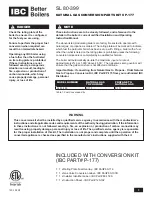
38
15.7
Operational Adjustments
P
1
P
2
OFF ON
A
1
A
2
A
3
A
4
ON
OFF
B
1
B
2
B
3
B
4
Factory setting
F
IG
. 15.5
P
Note : After the power has been cut to the boiler, or the
P.C.B. has been reset the TAC is cancelled for 3
minutes.
- P1 :
Adjusts the Central Heating ouput power (see
Section 16).
- P2 :
Adjusts the ignition pressure of the boiler (soft-
light) between the minimum and maximum
setting
The J12 connector provided with a shunt is designed to
connect to either a room thermostat or external
programmer (see Section 12).
Once all adjustments have been completed, replace the
tab P and reassemble the boiler.
SETTINGS
The boiler is delivered with all dip switches set to the OFF position with the exception of B2 which is set to the ON position (Fig.
15.6). The maximum heating power can be adjusted by turning the potentiometer (P1) between the Min and Max position.
To do this it is first necessary to open the electrical box and proceed as follows:
Switch off the external power supply, remove the front panel (Section 18.2.1 and 18.2.2), Open the box by pressing the tab P (Fig.
15.5), the adjustment potentiometers are on the P.C.B. behind the tab P.
- A1 Sets the pump to operate permanently or stop when the room thermostat is satisfied.
- A2 Sets the operation of the pump to low or high speed for Central Heating operation.
- A3 Adjusts the Anti-Cycle delay for the Central Heating from 30 seconds to 3 minutes.
- A4 Sets the burner to fully modulating or step modulating (ON/OFF).
- B1 Sets the maximum Central Heating Temperature to either 85°C or 90°C
- B2 Selects or de-selects the programmer (For the UK and IE it must always be in the ON position).
- B3 No function
- B4 Sets the boiler to work in conjunction with the D.H.W. thermostatic cartridge kit, when in the on position the D.H.W. is set to a
fixed temperature of 60°C regardless of the postion of the D.H.W. temperature control knob 26 (Fig. 3.1)
P1
P2
OFF ON
1
2
3
4
1
2
3
4
P1
P2
F
IG
. 15.6
Summary of Contents for GENUS 30 Plus
Page 30: ...30 Airpressure Swi tch Ear th Ear th 13 Electrical System Diagrams FIG 12 4...
Page 62: ...62...
Page 63: ...63...
















































